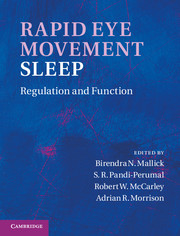Book contents
- Frontmatter
- Contents
- Contributors
- Preface
- Acknowledgments
- Organization
- Section I Historical context
- Section II General biology
- Section III Neuronal regulation
- 10 Understanding REM sleep: clues from brain lesion studies
- 11 Preoptic and basal forebrain modulation of REM sleep
- 12 Amygdalar regulation of REM sleep
- 13 Pontomedullary mediated REM-sleep atonia
- 14 Phenomenology and function of myoclonic twitching in developing rats
- 15 Pontine-wave generator: a key player in REM sleep-dependent memory consolidation
- 16 Hippocampal theta rhythm of REM sleep
- 17 Respiration during REM sleep and its regulation
- 18 Modulation of REM sleep by non-REM sleep and waking areas in the brain
- Section IV Neuroanatomy and neurochemistry
- Section V Functional significance
- Section VI Disturbance in the REM sleep-generating mechanism
- Index
- Plate section
- References
13 - Pontomedullary mediated REM-sleep atonia
from Section III - Neuronal regulation
Published online by Cambridge University Press: 07 September 2011
- Frontmatter
- Contents
- Contributors
- Preface
- Acknowledgments
- Organization
- Section I Historical context
- Section II General biology
- Section III Neuronal regulation
- 10 Understanding REM sleep: clues from brain lesion studies
- 11 Preoptic and basal forebrain modulation of REM sleep
- 12 Amygdalar regulation of REM sleep
- 13 Pontomedullary mediated REM-sleep atonia
- 14 Phenomenology and function of myoclonic twitching in developing rats
- 15 Pontine-wave generator: a key player in REM sleep-dependent memory consolidation
- 16 Hippocampal theta rhythm of REM sleep
- 17 Respiration during REM sleep and its regulation
- 18 Modulation of REM sleep by non-REM sleep and waking areas in the brain
- Section IV Neuroanatomy and neurochemistry
- Section V Functional significance
- Section VI Disturbance in the REM sleep-generating mechanism
- Index
- Plate section
- References
Summary
Summary
The medial pontomedullary reticular formation has been implicated in the control of motor activity in REM sleep. Electrical stimulation of points within this area elicits global inhibition of skeletal motor activity in decerebrate animals. This area can be segregated into four distinct subregions based on the response to chemical stimulation. Injection of glutamate, acetylcholine, and corticotropin-releasing factor into the medial pons, the pontine inhibitory area, induces muscle atonia. In the medial medulla, the nucleus magnocellularis (NMC) of the rostroventral medulla responds to glutamate and corticotropin-releasing factor and the nucleus paramedianus of the caudomedial medulla responds to acetylcholine injection, with suppression of muscle tone being induced by these chemicals. In contrast, the transmitter involved in elicitation of atonia by electrical stimulation of the nucleus gigantocellularis of the dorsomedial medulla is unclear. Lesions in this area increase phasic and tonic muscle activity in REM sleep in the chronic animal. Our recent study found that an area rostral to the pons, located at the ventral portion of the junction of the midbrain and pons, the ventral mesopontine junction (VMPJ), is also involved in the control of muscle activity in sleep. Neurotoxic lesions of the VMPJ produce periodic leg movements in slow-wave sleep and increase phasic and tonic muscle activity in REM sleep in the cat, symptoms resembling the human REM sleep behavior disorder (RBD). The anatomical proximity of the VMPJ and the substantia nigra may thus provide a link between RBD and Parkinsonism.
- Type
- Chapter
- Information
- Rapid Eye Movement SleepRegulation and Function, pp. 121 - 129Publisher: Cambridge University PressPrint publication year: 2011



